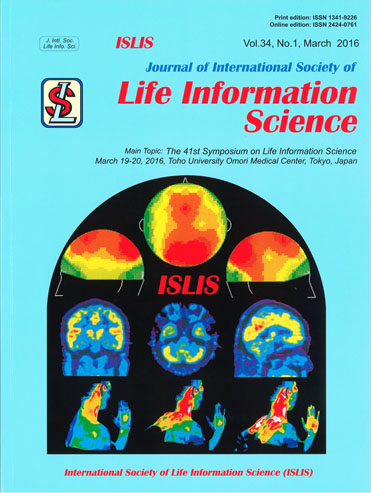Volume 23, Issue 1
Displaying 51-91 of 91 articles from this issue
The 19th Symposium on Life Information Science
-
Article type: Article
2005Volume 23Issue 1 Pages 133-143
Published: March 01, 2005
Released on J-STAGE: May 03, 2019
Download PDF (1049K) -
Article type: Article
2005Volume 23Issue 1 Pages 144-154
Published: March 01, 2005
Released on J-STAGE: May 03, 2019
Download PDF (1188K) -
Article type: Article
2005Volume 23Issue 1 Pages 155-
Published: March 01, 2005
Released on J-STAGE: May 03, 2019
Download PDF (104K) -
Article type: Article
2005Volume 23Issue 1 Pages 156-
Published: March 01, 2005
Released on J-STAGE: May 03, 2019
Download PDF (166K) -
Article type: Article
2005Volume 23Issue 1 Pages 157-
Published: March 01, 2005
Released on J-STAGE: May 03, 2019
Download PDF (140K) -
Article type: Article
2005Volume 23Issue 1 Pages 158-160
Published: March 01, 2005
Released on J-STAGE: May 03, 2019
Download PDF (231K) -
Article type: Article
2005Volume 23Issue 1 Pages 161-163
Published: March 01, 2005
Released on J-STAGE: May 03, 2019
Download PDF (332K) -
Article type: Article
2005Volume 23Issue 1 Pages 164-168
Published: March 01, 2005
Released on J-STAGE: May 03, 2019
Download PDF (379K) -
Article type: Article
2005Volume 23Issue 1 Pages 169-173
Published: March 01, 2005
Released on J-STAGE: May 03, 2019
Download PDF (506K) -
Article type: Article
2005Volume 23Issue 1 Pages 174-176
Published: March 01, 2005
Released on J-STAGE: May 03, 2019
Download PDF (232K) -
Article type: Article
2005Volume 23Issue 1 Pages 177-178
Published: March 01, 2005
Released on J-STAGE: May 03, 2019
Download PDF (281K) -
Article type: Article
2005Volume 23Issue 1 Pages 179-183
Published: March 01, 2005
Released on J-STAGE: May 03, 2019
Download PDF (393K) -
Article type: Article
2005Volume 23Issue 1 Pages 184-188
Published: March 01, 2005
Released on J-STAGE: May 03, 2019
Download PDF (505K) -
Article type: Appendix
2005Volume 23Issue 1 Pages 189-
Published: March 01, 2005
Released on J-STAGE: May 03, 2019
Download PDF (48K) -
Article type: Appendix
2005Volume 23Issue 1 Pages 189-
Published: March 01, 2005
Released on J-STAGE: May 03, 2019
Download PDF (48K)
Journal of ISLIS
-
Article type: Appendix
2005Volume 23Issue 1 Pages 190-191
Published: March 01, 2005
Released on J-STAGE: May 03, 2019
Download PDF (91K) -
Article type: Appendix
2005Volume 23Issue 1 Pages 192-
Published: March 01, 2005
Released on J-STAGE: May 03, 2019
Download PDF (70K) -
Article type: Appendix
2005Volume 23Issue 1 Pages 193-
Published: March 01, 2005
Released on J-STAGE: May 03, 2019
Download PDF (48K) -
Article type: Appendix
2005Volume 23Issue 1 Pages 194-
Published: March 01, 2005
Released on J-STAGE: May 03, 2019
Download PDF (59K)
International Research Institute (IRI)
-
Article type: Appendix
2005Volume 23Issue 1 Pages 195-196
Published: March 01, 2005
Released on J-STAGE: May 03, 2019
Download PDF (117K) -
Article type: Appendix
2005Volume 23Issue 1 Pages 197-
Published: March 01, 2005
Released on J-STAGE: May 03, 2019
Download PDF (82K) -
Article type: Appendix
2005Volume 23Issue 1 Pages 198-199
Published: March 01, 2005
Released on J-STAGE: May 03, 2019
Download PDF (105K) -
Article type: Appendix
2005Volume 23Issue 1 Pages 200-
Published: March 01, 2005
Released on J-STAGE: May 03, 2019
Download PDF (75K)
International Society of Life Information Science (ISLIS)
-
Article type: Appendix
2005Volume 23Issue 1 Pages 201-202
Published: March 01, 2005
Released on J-STAGE: May 03, 2019
Download PDF (109K) -
Article type: Appendix
2005Volume 23Issue 1 Pages 203-
Published: March 01, 2005
Released on J-STAGE: May 03, 2019
Download PDF (54K) -
Article type: Appendix
2005Volume 23Issue 1 Pages 204-
Published: March 01, 2005
Released on J-STAGE: May 03, 2019
Download PDF (59K) -
Article type: Appendix
2005Volume 23Issue 1 Pages 205-
Published: March 01, 2005
Released on J-STAGE: May 03, 2019
Download PDF (73K) -
Article type: Appendix
2005Volume 23Issue 1 Pages 206-208
Published: March 01, 2005
Released on J-STAGE: May 03, 2019
Download PDF (158K) -
Article type: Appendix
2005Volume 23Issue 1 Pages 209-
Published: March 01, 2005
Released on J-STAGE: May 03, 2019
Download PDF (85K) -
Article type: Appendix
2005Volume 23Issue 1 Pages 210-
Published: March 01, 2005
Released on J-STAGE: May 03, 2019
Download PDF (86K) -
Article type: Appendix
2005Volume 23Issue 1 Pages 211-
Published: March 01, 2005
Released on J-STAGE: May 03, 2019
Download PDF (76K) -
Article type: Appendix
2005Volume 23Issue 1 Pages 212-
Published: March 01, 2005
Released on J-STAGE: May 03, 2019
Download PDF (74K) -
Article type: Appendix
2005Volume 23Issue 1 Pages 213-
Published: March 01, 2005
Released on J-STAGE: May 03, 2019
Download PDF (67K) -
Article type: Appendix
2005Volume 23Issue 1 Pages 214-215
Published: March 01, 2005
Released on J-STAGE: May 03, 2019
Download PDF (64K) -
Article type: Appendix
2005Volume 23Issue 1 Pages 216-
Published: March 01, 2005
Released on J-STAGE: May 03, 2019
Download PDF (38K) -
Article type: Appendix
2005Volume 23Issue 1 Pages 217-
Published: March 01, 2005
Released on J-STAGE: May 03, 2019
Download PDF (114K) -
Article type: Appendix
2005Volume 23Issue 1 Pages 218-
Published: March 01, 2005
Released on J-STAGE: May 03, 2019
Download PDF (48K) -
Article type: Appendix
2005Volume 23Issue 1 Pages App4-
Published: March 01, 2005
Released on J-STAGE: May 03, 2019
Download PDF (42K) -
Article type: Appendix
2005Volume 23Issue 1 Pages App5-
Published: March 01, 2005
Released on J-STAGE: May 03, 2019
Download PDF (42K) -
Article type: Appendix
2005Volume 23Issue 1 Pages App6-
Published: March 01, 2005
Released on J-STAGE: May 03, 2019
Download PDF (38K) -
Article type: Appendix
2005Volume 23Issue 1 Pages App7-
Published: March 01, 2005
Released on J-STAGE: May 03, 2019
Download PDF (38K)
